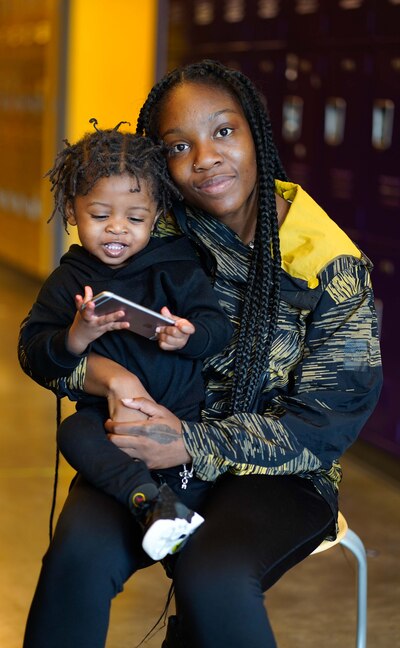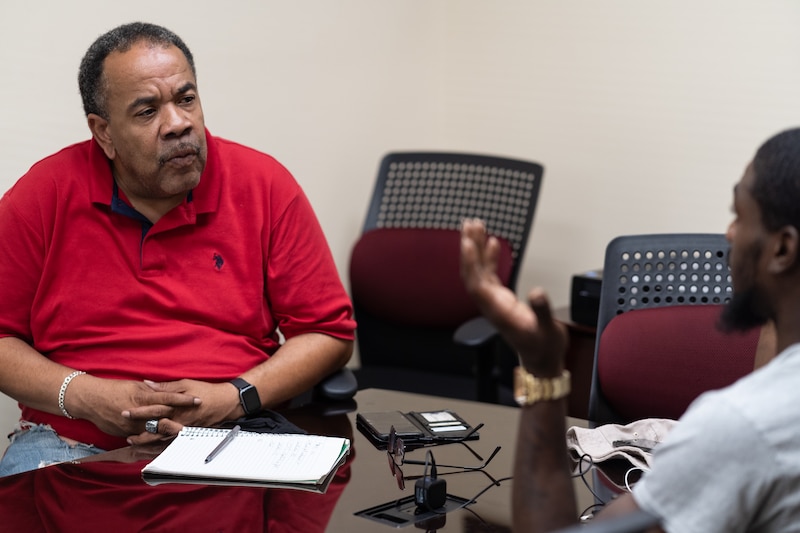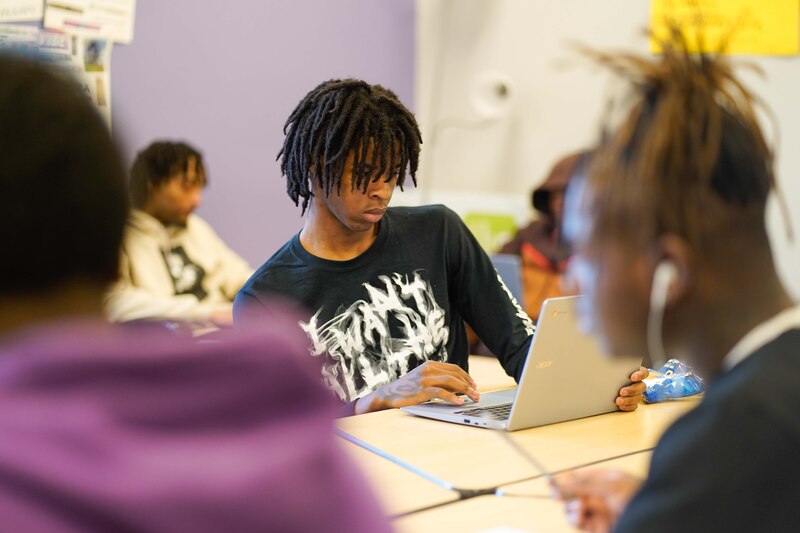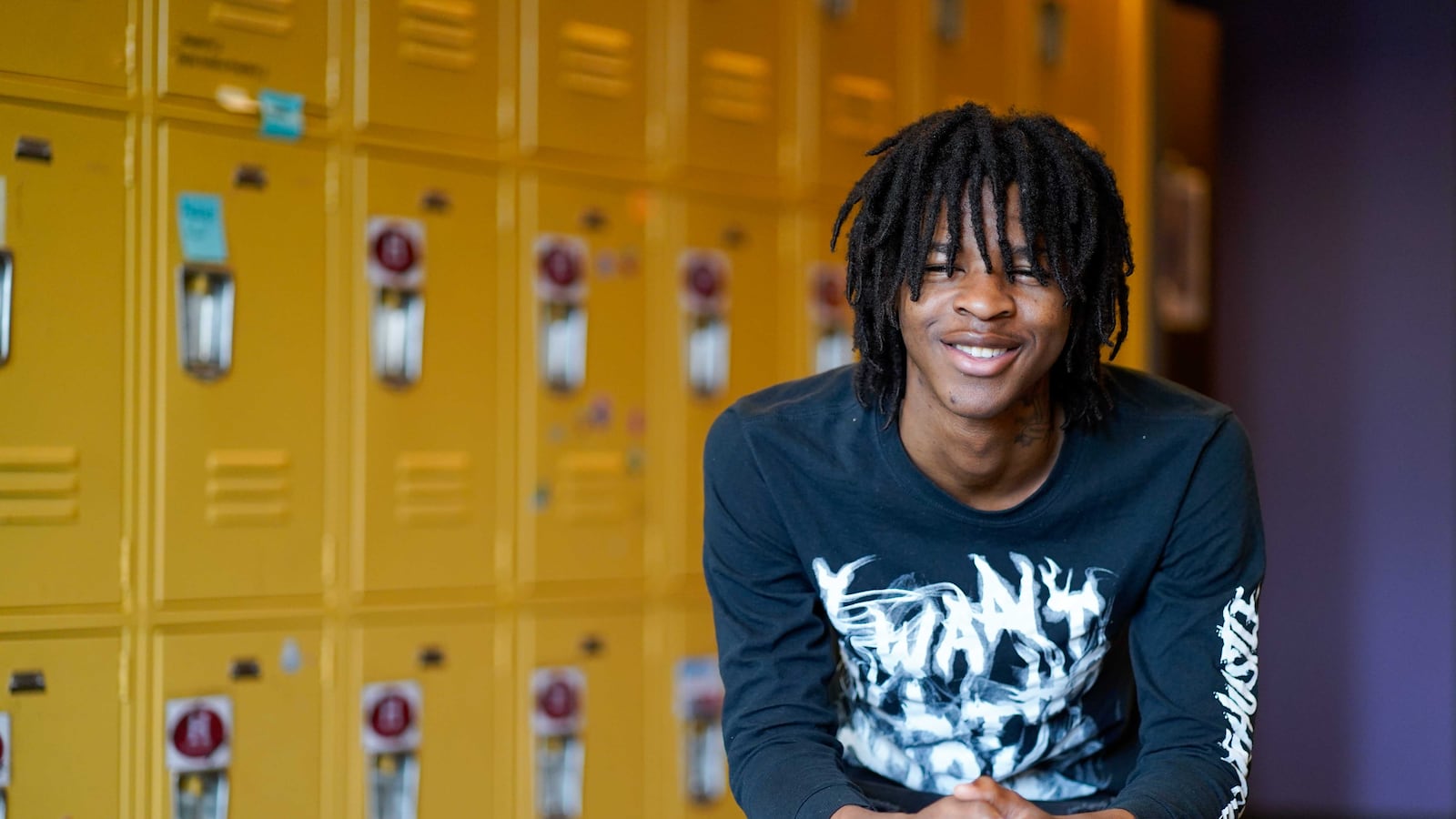Last winter, Alonte Wilson had written off ever getting a high school diploma. He was 18, woefully short on credits and full of uncertainty about his future.
Then he got a series of texts from an outreach worker at Breakthrough Urban Ministries, a nonprofit on Chicago’s West Side:
“Here’s something that can help you so you’re not just sitting in the house doing nothing.”
Wilson could get another crack at finishing high school, the texts promised. He could also receive therapy, mentoring, and job readiness training — and get paid $250 a week while he was at it.
Wilson was skeptical, but intrigued.
In Chicago, an estimated 45,000 teens and young adults like Wilson are not in school, college, or the workforce. That’s roughly 15% of the city’s 16- to 24-year-old residents. City leaders and experts have long seen reengaging these young people — whom they call “Opportunity Youth” — as crucial to addressing poverty, racial inequities, and gun violence.
But the task has bedeviled the city for at least the past decade.
The pandemic triggered a renewed sense of urgency as the number of disconnected youth grew. Reconnection Hubs run by nonprofits in Roseland and Little Village added in-house therapists and street outreach. The school district launched Back to Our Future, which it sees as a first-of-its-kind program to reengage the toughest-to-reach dropouts with help from nonprofits such as Breakthrough.
But overall, Chicago’s programs are often fragmented and lack the big-picture vision and coordination between nonprofits and government agencies that experts say are key to success. Data on young people’s longer-term outcomes is scarce. And programs tend to reel in youth who are still somewhat connected — going to community college or working part-time, for example — not the most difficult to reach.
Now, newly elected Mayor Brandon Johnson, who pledged to double jobs and invest in programs for young people, has become the latest city leader hoping to solve the youth disconnection issue.
The stakes are high: Disconnected teens and young adults suffer a long-term toll on their health, social-emotional development, and relationships. In Chicago, more than 90% of young gun violence victims are not enrolled in school, the University of Chicago Education Lab has found. And according to one often-cited 2012 Columbia University study, each disconnected youth carries on average an almost $940,000 lifetime cost to society in lost tax revenue, higher government spending, and other costs.
“These are the most vulnerable youth in our community,” said Yolanda Fields, Breakthrough’s executive director. “What we’re trying to communicate is, ‘You’re worth it. We’ve come for you.’”
Chicago has grappled with youth disconnection for years
Wilson was in third grade – often viewed as a critical predictor of academic success – when the issue of out-of-school, out-of-work youth first loomed large in the national conversation. He was growing up on the West Side, in an area that has long struggled with disinvestment and gun violence.
In 2013, many Black families were leaving Chicago, and the city was in the midst of shuttering almost 50 elementary schools on the South and West sides, the largest mass school closures in the United States.
The Great Recession had left a lingering toll on youth employment. The Obama administration made reengaging out-of-school, out-of-work young people a signature initiative, spurring national campaigns and the birth of new organizations devoted to the issue. Chicago pledged to reckon with disconnection as well.
Advocates and city leaders at the time often cited a striking number: More than 50,000 youth ages 16 through 24 were not going to school or working.
While officials have tied the goal of reconnecting them to preventing gang recruitment and crime, many of these young people were derailed instead by poverty, parenthood, mental health issues, and a lack of jobs in some swaths of a segregated city.
In 2013, the school district opened Student Outreach and Re-Engagement Centers in Little Village, Roseland, and Garfield Park — its first attempt to track down and cajole back thousands of dropouts. But the centers could not help disconnected youth who had aged out of school or those who already had a high school diploma, which more than half of disengaged 16- to 24-year-olds do.
In the following years, then-Mayor Rahm Emanuel’s administration helped launch Thrive Chicago, an organization meant to connect nonprofits and agencies who worked with disengaged youth. With grants from the city, Thrive helped start two Reconnection Hubs, in Roseland in 2018 and Little Village in 2019.
The Hubs, which share space with two of the school district’s reengagement centers, were designed to be a one-stop shop for youth grappling with disconnection — helping them with basic needs such as housing and transportation, and offering leads on jobs or job training programs.
Government investment in reconnecting youth can mean “the difference between a life of poverty and a life of prosperity,” Emanuel said in announcing a 2017 Opportunity Youth Summit that the mayor’s office co-hosted with Thrive.
By the eve of the pandemic in 2019, Thrive had also compiled a trove of U.S. Census data shedding new light on these young people. That year, their numbers had dropped to 37,000, but the decrease was not necessarily a sign of success. Mainly, there were fewer teens and young adults living in Chicago overall, while a resurgent national economy had given youth hiring a boost, said Matthew Wilson at the University of Illinois Chicago’s Great Cities Institute.
In Chicago, the rate of teens and young adults not in school, college, or the workforce had remained relatively steady at 12%. For Black youth, it was almost 25%.
And the highest concentration of such youth is in the area where Wilson grew up on the West Side.
Chicago launches another new program amid disconnect
The tenuous relationship Wilson had with school unraveled completely after the COVID pandemic hit. At Orr High School, “Zoom school” failed to hold his attention and gave him license to tune out altogether.
He failed a string of classes and fell short on credits. Gun violence in his neighborhood and across the city claimed friends, he said. Then in 2021, Wilson himself was shot, and his family sent him to live in Florida for a time, where he attended an alternative high school.
He returned to Chicago early the following year. Seven months later, according to a police report, Wilson was arrested on the West Side and charged when officers responding to a gathering of young people noticed he had a gun — illegal in Illinois for people under age 21 — which he later told police he carried for protection.
In the months that followed, as the city crawled back to normal after two years of COVID restrictions, Wilson sat in home confinement and took stock of his murky prospects.
“My life was paused, and I couldn’t do what I wanted to do,” he said.
Wilson’s experience reflects a larger truth: Young people — especially Black youth — were hit harder by the fallout from COVID and, here in Chicago, they have been much slower to recover, according to a recent University of Illinois Chicago report. The jobless rate for Black women in their early twenties doubled from 2019 to 2021, climbing to almost 60%.
Nationally, experts and advocates hoped the pandemic would bring new energy and federal money to address the issue of out-of-school, out-of-work youth, as it did in the aftermath of the Great Recession, said Louisa Treskon, senior associate at the think tank MDRC. Largely, that hasn’t been the case.
“So many young people now have heightened needs and are struggling,” Treskon said. “That has overshadowed the more specific needs of opportunity youth.”
Chicago, however, set out to try a new approach. The district’s new Back to Our Future program launched last year aims to do “relentless engagement” — intensive outreach to persuade youth disengaged from school for more than a year and their families to give the program a chance.
During the initial 12 weeks of the program, they would get more services than the district’s Student Outreach and Re-Engagement Centers had ever offered: mentorship, mental health services, “soft skills” training, help with finding a job, and a $15.40 an hour stipend.
The catch: A price tag of $18,000 per student, along with the novelty of the approach, meant the district would start small. It would aim for reaching 1,000 students in 15 neighborhoods on the South and West sides during the program’s first year.
With funding from the Office of Firearm Violence Prevention at the Illinois Department of Human Services, the district signed one-year contracts last spring totaling almost $20 million with three nonprofits to run Back to Our Future, including Garfield Park’s Breakthrough, a faith-based organization that runs housing, violence prevention, and other programs.
Fields, the executive director at Breakthrough, says the nonprofit has long offered local public school students arts, sports, and other enrichment programs. But it had never before provided services for dropouts.
The contracts task Breakthrough and the other partners with targeting youth at high risk of becoming victims of violence or getting involved with the criminal justice system.
“This is where our investment should be,” school board member Elizabeth Todd-Breland said last summer after district officials touted the new program. “Not on the back end in criminalizing, in caging — but on the front end.”
Reengagement work happens one student at a time
Wilson started coming to Breakthrough for Back to Our Future in January, enticed by the texts from the outreach worker. The program put Wilson on the GED prep track, for students who are older and shorter on credits.
Other participants start on an online credit recovery program. For some, the program might lead to a return to a more traditional high school setting, but not until months down the road.
As the weeks went by, the staff chipped away at Wilson’s initial skepticism.
He started seeing a therapist. When his cell phone company blocked his account, the program covered his unpaid bill — what Breakthrough staff call a “sticky factor,” or help with day-to-day life challenges that shores up relationships with the students, factored into the cost of the program.
When he skipped days — something he had always felt caused barely a ripple in high school — staff texted and called right away, coaxing him back.
“It’s like a family, but it’s cool,” he said.
This spring, Wilson sat in a hushed room on the second floor at Breakthrough’s sleek, modern complex, off a hallway with yellow and purple lockers. There was a smattering of desks, a whiteboard, and a list of “rules and regulations” on the wall that proclaimed the space a “no judgment zone.”
Wearing a black shirt with “Born to Hustle” emblazoned along the sleeve, Wilson stared at a math problem on a laptop screen: If a painter rented a wallpaper steamer at 9 a.m., returned it at 4 p.m., and paid $28.84, what was the rental cost per hour?

A couple of young women holding toddlers by the hand rushed in and were handed their own laptops. One of them, Tamaya McGowan, was also working on her GED and eyeing a construction training program at Malcolm X Community College this fall.
To Myisha McGee, Breakthrough’s director of high school and postsecondary education, Wilson became a cross between resident recruiter and teacher’s aide. Half a dozen friends joined the program as well. When other teens showed disrespect, he would raise his voice so McGee didn’t have to, or he’d pull them aside to say, “Hey, we don’t do that here.”
Thanks to the job readiness training students receive, Wilson learned how to present himself to potential employers. He crafted a 30-second “elevator speech.”
“Hey, how you doing? My name’s Alonte Wilson, and I go to Breakthrough to get my GED, so I can go to trade school and start to change my jam and become an architect or engineer.”
Advocates say the latest efforts to connect with disengaged youth are paying off.
Sidney Johnson, a soft-spoken, avuncular therapist hired by the Reconnection Hub in Roseland during the pandemic, urges clients to “focus on what you can control” and “create your own narrative.” He says almost all the young people the Hub serves have experienced childhood trauma, and unmasking how it’s shaping their self-esteem and behavior now can be powerful.
Chicago Public Schools officials also say Back to Our Future is off to a promising start. So far, 465 students have taken part — short of the program’s Year 1 goal of 1,000 students spelled out in its contracts. Attendance has ups and downs, but most teens have stuck with the program.
Some of the 86 students Breakthrough has served dropped off after the end of the first paid 12 weeks. Three have gotten arrested. One 19-year-old was shot and killed in the neighborhood earlier in June.
But most are engaged, said McGee, and her hope is that some will have earned enough credits to return to traditional school this fall.
Are Chicago’s efforts reconnecting young people? It’s tough to say.
At the Reconnection Hub in Little Village, many young people walk in seeking something specific: help with removing a gang tattoo, finding child care, or getting a public transit pass.
Director Pedro Mendez says his team has specialized in trouble-shooting these hurdles to reengagement. Staff at the Hub — an area with cluttered desks and a couple of classrooms in the back of a nonprofit above a shopping center — try to build a longer-term relationship with youth they help, steering them to, say, an in-house GED, photography, or coding classes, or job training.

But here and in Roseland, staying in touch longer term is a challenge. And it’s hard to come by data on education and employment outcomes for participants in Chicago’s patchwork of programs.
Data Chicago Public Schools provided in response to a Freedom of Information Act shows its Student Outreach and Re-engagement Centers — the program the district started a decade ago to reengage dropouts — have seen the number of students they serve shrink dramatically, from 3,245 in 2016 to 655 in 2022, even as the district launched a new center in Englewood in partnership with City Colleges of Chicago in 2021.
About a quarter of the students who visited a reengagement center in 2022 graduated that year, district data shows. But the district doesn’t track how many graduate beyond the year they make contact with the program — or what happens afterwards. The district did not respond to questions about the centers, except to say that officials will reassess the program in the fall.
This year, Thrive Chicago completed an evaluation of the Reconnection Hubs program, but did not make it public. Several former employees who have seen the report and spoke with Chalkbeat anonymously said it echoed what staff at the Hubs told Chalkbeat: The Hubs have provided important services for almost 3,000 young people.
But there is no data on how they have fared in helping youth complete their education or find jobs.
According to the former employees, the report also said that the Hubs veered from a vision for the program in which they would size up young people’s needs, make a plan — and then refer them to nonprofits or government agencies that can best serve them. That vision was an awkward fit for a nonprofit ecosystem in which local and state funding is based on the number of clients on the Hubs’ own caseloads.
Then in May, Thrive shut down abruptly. The group’s board president, Timothy Schwertfeger, did not respond to requests for comment.
The state did not respond by the time of publication to a Chalkbeat request for attendance and other outcome numbers for Back to Our Future. The University of Chicago’s Education and Crime Labs is slated to produce a more formal evaluation, with some findings set to come out later this summer.
Nationally, the relatively small number of reengagement programs that have been rigorously studied have generally yielded modest increases in high school completion and earnings.
“There’s been this thread of, ‘Nothing really works,’” said Treskon, the MRDC expert.
In fairness, she notes, these programs work with youth with extremely high needs, many of whom have experienced trauma and other hardships. Programs are often too short-lived to effectively bend the trajectories of young people’s lives. Few cities have perfected what experts believe are all-important “smooth handoffs” — partnerships between the nonprofits and government agencies that together can meet this group’s complex needs, free of competition for grants and other funding.
In Back to Our Future’s first 12 weeks of intensive support, Treskon says, the program seems to deliver the gold standard: engagement with families, trauma-informed mentoring and counseling, a stipend, and “soft skills” job readiness training. The big test is what happens after that.
On his first day in office in May, Chicago Mayor Johnson signed an executive order directing his team to come up with a detailed plan for how to double the number of youth jobs, starting with opening more positions for young people in city government. His deputy for education, youth, and human services, Jen Johnson, recently told Chalkbeat that cross-department and agency collaboration will be key in tackling disengagement — and touted the Back to Our Future program as a promising approach.

For his part, Wilson, now 19, has continued to show up at Breakthrough even though he stopped receiving his stipend weeks ago.
No longer on home confinement, he said he now has a part-time job at Walgreens and is close to taking his GED exams.
“I’ve learned how to switch my ways,” Wilson said.
Wilson’s post-GED game plan is still “all over the place,” says McGee, Breakthrough’s education director. But the program has a “Trades Day” coming up, and McGee hopes to take him on some college tours.
In the meantime, Wilson has a job interview outfit picked out: white button-down shirt, black slacks, black dress shoes. “You gotta look like you really want the job,” he said.
And he has kept practicing his elevator speech, tweaking it with input from staff and peers to swap out his dream job of architect for mechanic.
“I have soft skills like communication skills, listening skills, time management, and teamwork,” he recited during a mock interview day at Breakthrough one recent Friday. “I am very interested in discussing my skills and would like to schedule an interview with you at your earliest date.”
Mila Koumpilova is Chalkbeat Chicago’s senior reporter covering Chicago Public Schools. Contact Mila at mkoumpilova@chalkbeat.org.

